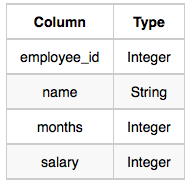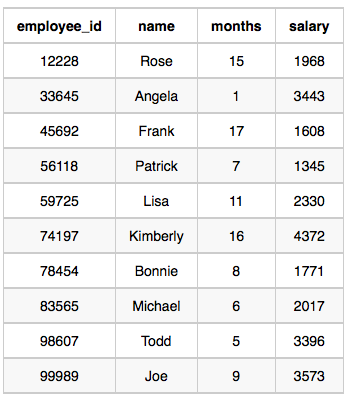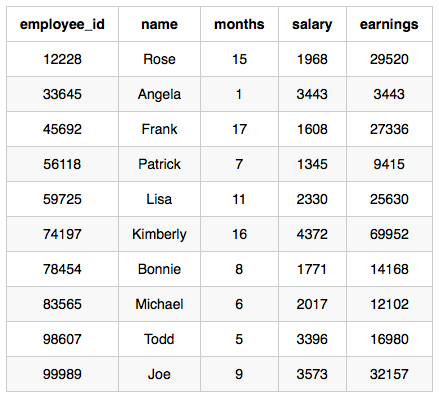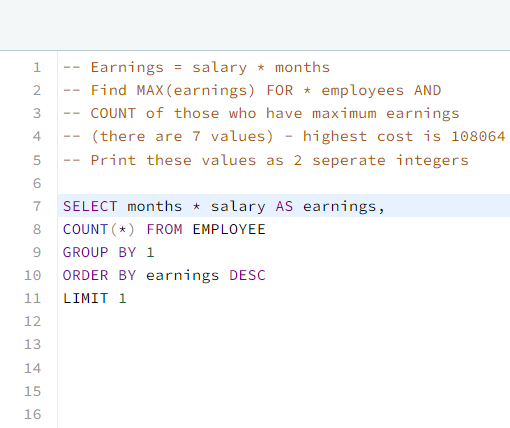Publish Date - November 12th, 2022
|Last Modified - November 12th, 2022
Here’s a quick an easy SQL Hackerrank solution for one of the last “aggregate” courses. It’s an interesting one because you can end up overthinking your approach.
The problem
We define an employee’s total earnings to be their monthly salary x months worked, and the maximum total earnings to be the maximum total earnings for any employee in the Employee table. Write a query to find the maximum total earnings for all employees as well as the total number of employees who have maximum total earnings. Then print these values 2 as space-separated integers.
Input Format
The Employee table containing employee data for a company is described as follows:

where employee_id is an employee’s ID number, name is their name, months is the total number of months they’ve been working for the company, and salary is the their monthly salary.
Sample Input

Sample Output
69952 1
Explanation
The table and earnings data is depicted in the following diagram:

The maximum earnings value is 69952 . The only employee with earnings = 66952 is Kimberly, so we print the maximum earnings value (66952) and a count of the number of employees who have earned $66592 (which is 1) as two space-separated values.
The solution
The solution is a lot easier to understand once you know what you need to query. I commonly add comments to organize my thoughts and to almost pseudo code what is required from me.
-- Earnings = salary * months
-- Find MAX(earnings) FOR * employees AND
-- COUNT of those who have maximum earnings
-- (there are 7 values) - highest cost is 108064
-- Print these values as 2 seperate integers
SELECT months * salary AS earnings,
COUNT(*) FROM EMPLOYEE
GROUP BY 1
ORDER BY earnings DESC
LIMIT 1
If you can see, I’ve added a number of notes to analyze what’s required from the query. The maximum earnings is 108064, and there are 7 people out of 108 who earn that much. Therefore, with that knowledge you can begin to constructor your query.
Firstly, you need to generate the calculation to get “earnings”
SELECT months * salary AS earnings, Easy enough! Since it’s a quick multiplication!
Next, within the second column, you’ll want COUNT all columns from employee, because doing this as a secondary column will give you the full count of all of the rows (which are 106).
COUNT(*) FROM employee Now because this is an aggregation function (COUNT), you must have a HAVING or GROUP clause added to this or it will throw an error. If you GROUP BY 1, you’re essentially asking SQL to GROUP all values of 1 towards a particular earnings.
SELECT months * salary AS earnings, COUNT(*) FROM employee
GROUP BY 1
Returns:
1860 1
2086 1
2113 1
2438 1
2492 1
2717 1
3768 1
3958 1
4199 1
4583 1
4672 1
5760 1
8776 1
8780 1
8875 1
9072 1
9664 1
11240 1
11388 1
11799 1
12728 1
13017 1
13461 1
16848 1
17046 1
17424 1
17450 1
18720 1
19180 1
19206 1
19338 1
19665 1
20036 1
20295 1
20832 1
21021 1
21690 1
22160 1
22890 1
24474 1
24548 1
24800 1
25104 1
27544 1
27630 1
28386 1
29648 1
30450 1
30870 1
30898 1
30978 1
31140 1
31614 1
31680 1
32538 2
32718 1
32890 1
33235 1
33787 1
34590 1
37080 1
40352 1
41338 1
41360 1
41976 1
43301 1
45909 1
45980 1
47554 1
47794 1
50738 1
50876 1
54782 1
54960 1
56550 1
57132 1
59736 1
60300 1
61056 1
61789 1
66570 1
66937 1
68628 1
70095 1
70110 1
74080 1
77717 1
80454 1
81136 1
82236 1
83424 1
83644 1
86800 1
89012 1
89936 1
90816 1
91241 1
101154 1
108064 7 If you look at the bottom, you’ll notice you have your answer :). So all you need to do is clean up the query with some an ORDER BY and a LIMIT, and you have your answer.
Conclusion
Like I said, an easy query once you know the answer – and figured out what you have to do! I racked my brain with this one, thinking that I need to use MAX, subqueries and even a JOIN at once to figure this out. Ultimately, the simplest solution is usually the best!
Feel free to check out my articles on related technologies:
